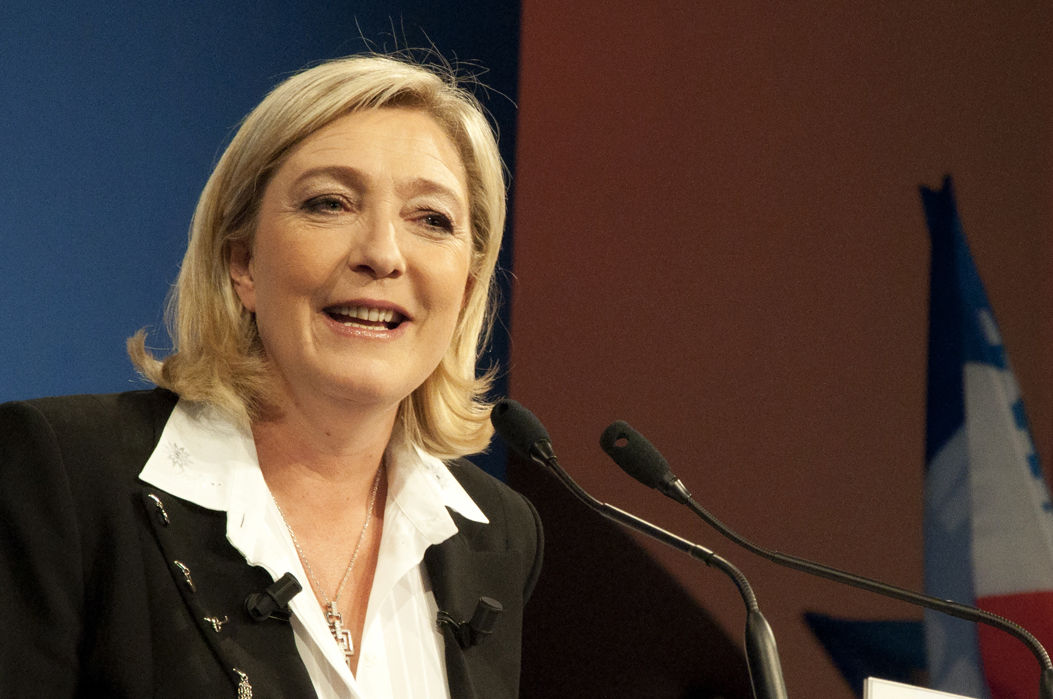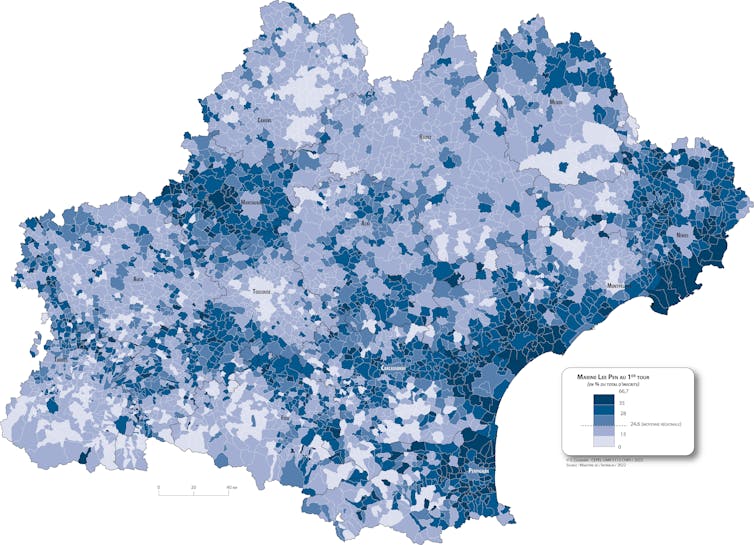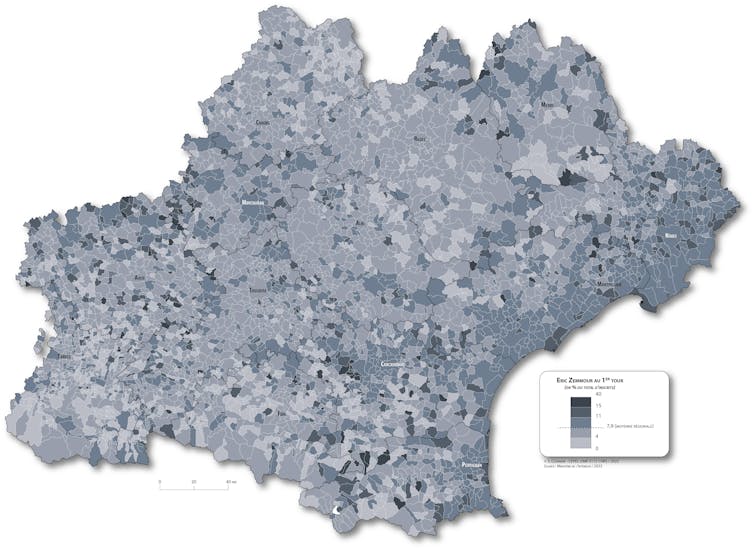Marine Le Pen: a campaign of paradoxes
Everything seemed new in Marine Le Pen's third presidential campaign. In ten years, she has seen her first-round vote capital grow from 6,421,426 in 2012 to 7,678,491 (then 10,638,475 in the second round) in 2017, and finally to 8,136,369 on April 10.
Emmanuel Négrier, University of Montpellier and Julien Audemard

This progression is all the more significant as it continued to take place in the presence of a strong challenger to the far-right, Éric Zemmour (2,485,935 votes in the first round).
Have these changes taken Marine Le Pen's candidacy beyond its usual tribune-like posture? In any case, they have come up against a number of limitations and paradoxes, which we propose to explain.
Programmatic refocusing
The trauma of the 2017 debate between the two rounds, where the candidate's unpreparedness for the confrontation between programs was obvious, will have convinced the Rassemblement National of the obvious: a campaign whose aim is to appear not only worthy of representing, but capable of governing, requires in-depth work on the program. If the strategy is to win over a growing share of a right-wing electorate in need of leadership, then the program needs to be adapted to the structure of this electorate, which is notoriously older and more conservative, and for whom spectacular measures (such as Frexit, for example) are undesirable adventures.
While Gilles Ivaldi counts a greater number of "social" measures, Marine Le Pen's program is not "more left-wing" than in 2017, on the contrary.
In its entirety, the program is still tilted to the right, with measures such as the increased exemption from inheritance tax, the abandonment of the 60-year retirement age for all and, after some hesitation, the refusal of a return to the Wealth Solidarity Tax (ISF). Not to mention, of course, what symbolically remains the social and economic cornerstone of Le Pen's program: systematic discrimination between French citizens and foreigners in terms of social, health and education benefits.
Significant developments in communications
However, the evolution in terms of communication is obvious, and it is notably due to a mutation in the entourage of Marine Le Pen, whose 2017 campaign was essentially captured by Florian Philippot. In 2022, she was surrounded by advisors mainly from the world of expertise, of which the "Horaces" think-tank is the symbol, somewhat akin to the "Gracques", a social-liberal think-tank founded during the 2007 presidential campaign, and which fed into Emmanuel Macron's 2017 campaign. Very well described by journalist Géraldine Woessner, the Horaces, formed as a think-tank as early as 2015, had remained on the bangs of the 2017 campaign.
While their number and importance within the French elite should not be exaggerated, valuable reinforcements have arrived from members of ministerial cabinets, enarques and representatives of the medical, social and economic sectors, such as Jean-Philippe Tanguy (ESSEC, Sciences Po Paris), Nicolas Dupont-Aignan's former collaborator, who at 35 has become Marine Le Pen's deputy campaign director. The technicalization of Marine Le Pen's entourage has thus been achieved at the risk of appearing more "classically" right-wing than disruptive.
To accompany this refocusing, the campaign style was also considerably modified. The elimination of blunt, potentially anxiety-provoking measures was matched by a more gentle image (the aunt saddened by her niece's betrayal, the staging of her relationship with her cats, the care taken to welcome her, the polite dialogue during her visits to the various campaign sites). The lesser emphasis on meetings compared to "micro-collective" visits also fuelled the idea of a low-key, potentially de-demonizing campaign.
But the major factor in refocusing Marine Le Pen's campaign came from outside, and against her very will. It was Éric Zemmour's major role, all the more useful in the first round as it validated the RN candidate's efforts to appear more "democratically" acceptable, against the polemicist's outrages.
Éric Zemmour's three functions
Éric Zemmour fulfilled three functions in the Le Pen campaign. The first is to have multiplied the presence of far-right themes, identity and migration issues, which are generally attributed to the extreme right. Vociferated (by Zemmour) and transformed into a program of public action (by Le Pen), these themes have, in the space of a few months, opened the Overton window to opinions worthy of debate in the public arena.
According to Joseph P.Overton (1960-2003), widening the window of opinion is the work of moving ideas first considered "unthinkable" to "radical", then "reasonable", then "popular", and finally leading to the adoption of public policies. In 2022, these ideas will of course include the "Great Replacement" theory, which has been played with by certain representatives of the Republican Right, led by Valérie Pécresse.
Éric Zemmour's second function is to have taken on the role of tribune with an assumed radicalism which, in turn, served as a "lightning rod" for the RN candidate. The best example of this is Zemmour's past reference to the dream of a French Putin, which, through its outrageousness, protected Marine Le Pen from overly insistent references to her links, at least as clear, with the Russian president and his entourage, particularly banking links. During the debate on April 20, Emmanuel Macron's mention of these links was bound to destabilize her.
Zemmour's third function is electoral. While the far right has, over the years, shown itself to be fairly strong in the first round of a majority election, it suffers in the second round from a lack of reserves and rallies. This time, Zemmour's capital (with a penetration into affluent segments resistant to the Le Pen vote) proves available for a more open second round, if the two can be added together.

Stéphane Coursière/CEPEL, Provided by the author

Stéphane Coursière/CEPEL, Provided by the author
The map of the first round shows the extent to which the two electorates differ on an inter-regional scale. However, if we focus on Occitanie alone, we can also see that the Zemmour electorate is strong in the very areas where the Le Pen vote is high: Aude, Gard, Pyrénées Orientales, Hérault. This observation can be extended to the entire coastal region. Marine Le Pen reached 26.6% against Éric Zemmour's 14% in the Alpes Maritimes, the same figures are 26.2% and 10.8% in the Bouches-du-Rhône, 30.6% and 13.3% in the Var. But this map of possible carry-over points to one of the paradoxes of Marine Le Pen's 2022 campaign, which we must now highlight.
Two electoral boundaries
A first limitation of Marine Le Pen's campaign strategy can be seen in the spatial distribution of votes in her favor: a comparison between the 2017 and 2022 maps shows, first and foremost, the great stability of the RN electorate. While electoral support for Marine Le Pen has indeed extended to a certain extent, this is by no means a generalization that would testify to the trivialization of the far-right vote. The map of the RN vote on Sunday April 10 reveals gaps precisely where dediabolization could have had an effect. This is first and foremost the case in urban centers, where the RN candidate's deficit is all the more considerable in a context where mobilization is relatively homogeneous from one territory to another. In towns with more than 100,000 inhabitants, Marine Le Pen won an average of just 12.3% of votes cast, compared with 29.5% for Emmanuel Macron and 31.3% for Jean-Luc Mélenchon.
This is also the case in the western part of the country, traditionally more resistant to the RN vote - the voting dividing line between Le Havre and Perpignan persists, despite the progression of RN scores over a very large part of metropolitan France, today as in the 1980s.
This first limitation is compounded by a sociological one. The moderation of Le Pen's discourse has not translated into an increase in the RN vote among the upper bangs, and the latter remains essentially a popular vote. This paradox is all the more detrimental to Marine Le Pen's quest for power, as the Mélenchon vote, which also performs well in segments of the working classes (civil servants, immigrant voters, etc.) that are largely hostile to the far right, stands in her way.
These two limitations mean that the RN electorate is probably still too specific to hope for a victory in the second round of the presidential election, despite the intensification of the candidate's campaign, particularly in the west.
A political limit
Finally, Marine Le Pen's campaign strategy comes up against a third limitation, this time of a political nature. This one, clearly visible in the period between the two rounds, can be broken down into three elements.
The first points to the limits of the expertise card. The April 20, 2022 debate demonstrated this. Often embarrassed and defensive on the most technical points of her program, she failed to destabilize the outgoing candidate on his record.
The latter, by treating Marine Le Pen (almost) like an ordinary rival, gave credence to her change of strategy - her dédiabolisation - the better to dominate her in the field of governmentality. At the same time, the period between the two elections highlighted the difficulties faced by the candidate and her entourage in dealing with recurrent criticism of the RN's traditional ideological base and its conservative, anti-immigration stance.
A second element adds to this difficulty: despite the increase in her electoral scores, Marine Le Pen still suffers from a lack of support, including from the right and, in some cases, from within her own camp. This deficit is largely explained by a third factor, which has to do with the persistence of the Le Pen brand, still infamous for many.
On Sunday April 24, a majority of voters will have to arbitrate between two sad passions: the fear of a Le Pen presidency, the incumbent's trump card, and the resentment towards Emmanuel Macron that the RN candidate intends to capitalize on. For Marine Le Pen, this arbitration of all dangers refers back to two major intrigues: her ability to maintain in the vote, beyond the presidential election, the popular bangs that seem to be won over to her, while consolidating her territorial extension and the normalization on which she relies.
From this point of view, the meeting of the Le Pen and Zemmour electorates will undoubtedly be a key to lasting leadership. In the longer term, the challenge for the RN is to overcome the boundary between the two popular blocs represented by the Le Pen and Mélenchon votes. Between respectability on the right and popular legitimacy, all the contradictions of a campaign are revealed.![]()
Emmanuel Négrier, CNRS Research Director in Political Science at CEPEL, University of Montpellier, University of Montpellier and Julien Audemard, Associate research scientist
This article is republished from The Conversation under a Creative Commons license. Read theoriginal article.